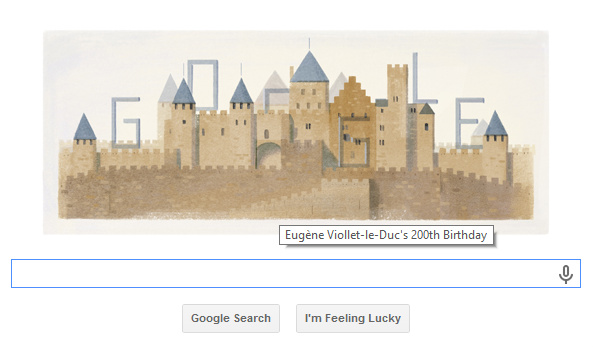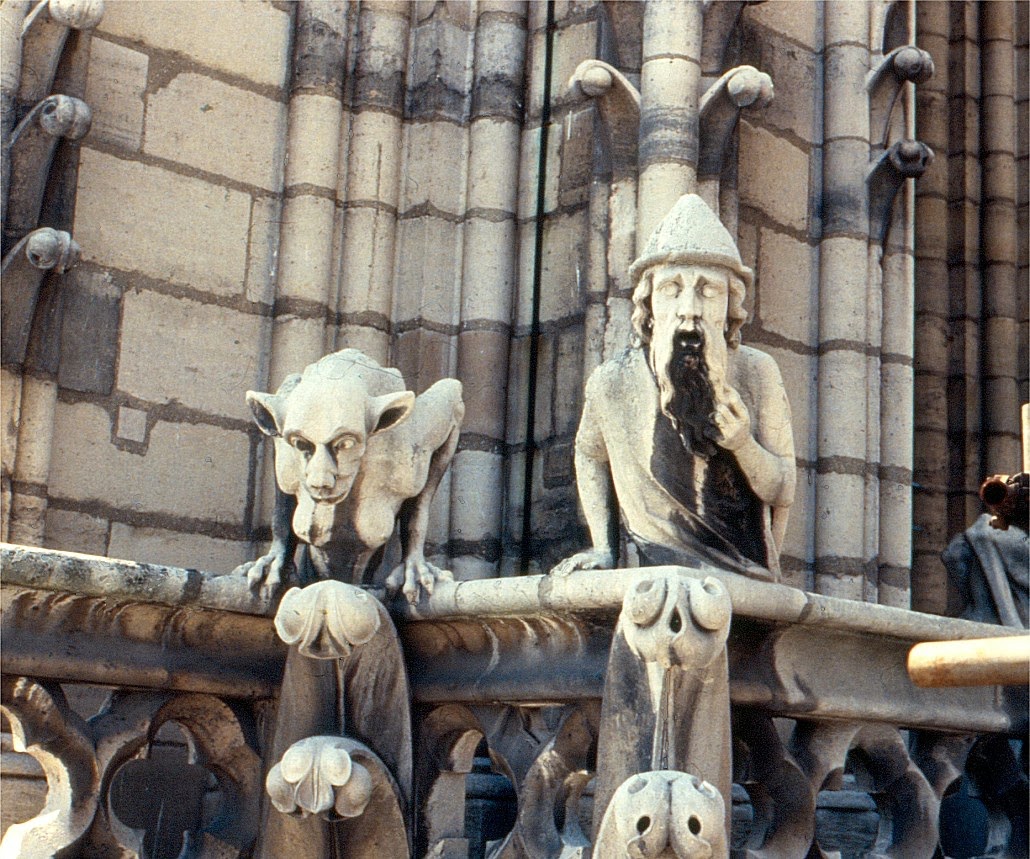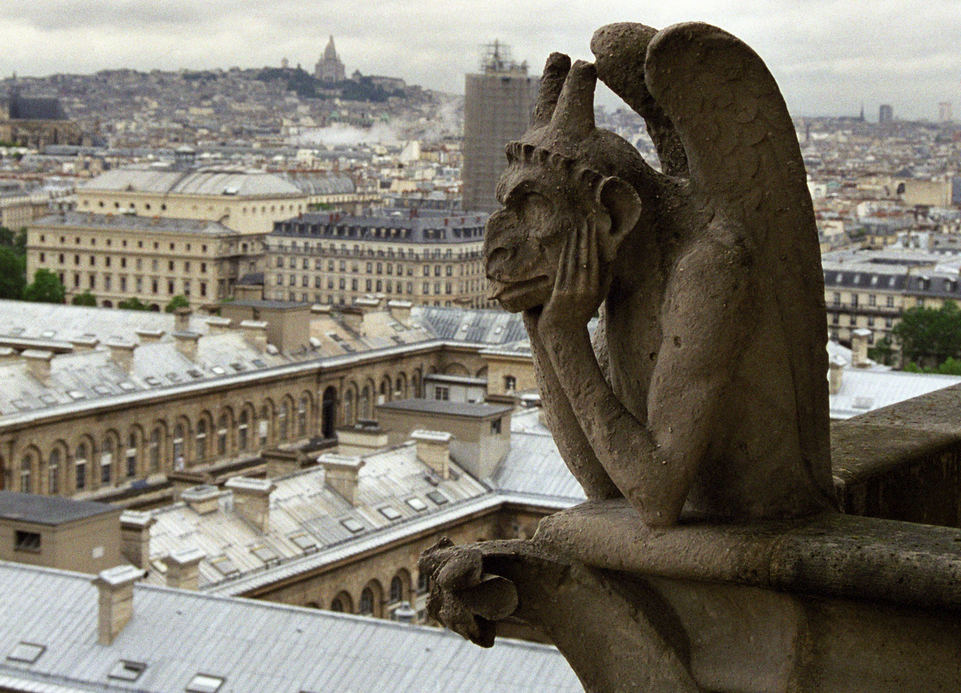[Note: As this is taken from an
archived site, some links and videos below may not be working.]
Google praises antisemitic architect on Holocaust day
With today being
Holocaust day, you might have thought that Google would have chosen to
commemorate it on their Google doodle, but you'd be mistaken, as today
Google chose instead to celebrate the bicentenary of the birth of French
architect Eugène Viollet-le-Duc who is perhaps most famous—outside of
France anyway—for his renovation (1845 - c.1865) of the Notre Dame de
Paris (Our Lady of Paris) cathedral with its renown gargoyles and
chimeras.
It was rather an unwise
choice of Google's, as it turns out that the Frenchman created one of
the most famous and widely loved antisemitic pieces of art in the world.
Of the 54 chimeras which
grace the cathedral Viollet-le-Du created only one depiction of an
actual human figure: the mythical "Wandering
Jew," although it's incorrectly claimed to be "the alchemist" by
neo-pagan types. The the late British professor of art Michael Camille
in his study The
Gargoyles of Notre-Dame states
that Viollet-le-Du created a highly sympathetic portrayal of the
Wandering Jew—minus his usual money-bag and scowl—and that the
sympathetic view of Jew cursed to endlessly walk the Earth was
common theme in the arts of mid-nineteenth century France due mostly to
the popular novel Le
Juif errant by
Eugène Sue. Which, essentially, cast the Jesuits as the bad guys.
According to Camile, being caught reading the novel would have had a
Catholic excommunicated and its author was exiled from France.
This is another of the
cathedral's chimeras, the most famous one; the one that graces the cover
of Michael Camille's book, and another that, according to Camille,
represents a Jew.
Camille devotes nine
pages of his book to this chimera in which he assiduously details each
of its features and speculates on Viollet-le-Du inspiration for them:
medieval works of art, contemporary studies into medieval art, and very
often, mid-nineteenth century scientific disciplines such as
physiognomy, phrenology, and craniology.
Camille writes of what
he calls "the most famous of all Viollet-le-Duc's creations":
"The pensive demon's
nose would have made him appear to his contemporaries very un-French, a
foreigner, if not more probably a Jew. [...]
Significantly, the shape
of the demon's head is elongated horizontally rather than vertically,
swerving away from the proper perpendicular of the good and the
beautiful toward the dark and Semitic. [...]
Faces that take this
particular form can be seen in numerous anti-Semitic propaganda images
produced in the first half of the nineteenth century, which show the
Jew's nose not as the audacious protrusion that would become typical of
the late nineteenth- and early twentieth-century anti-Semitic
stereotypes, but as an extension of the forehead, making it almost
reptilian. [...]
In 1850 Robert Knox
linked the Jewish with the African nose: "The African character of the
Jew, his muzzle-shaped mouth and face removing him from certain other
races ... lips very full, mouth projecting, chin small, and the whole
physiognomy, when swarthy, as it often is, has an African look." The
prominent mouth of some Jews was considered by some Aryan
anthropologists to be due to the presence of black blood. As for the
horns, some writers of the period linked the Semitic and the satanic."
Whilst summarising
Viollet-le-Duc's Wandering Jew and Demon Jew chimeras, Camille wrote:
"In his Lectures
on Architecture where he discusses the chimeras of
Notre-Dame, Viollet-le-Duc quotes the twelfth-century abbot of Cluny,
Peter the Venerable, who described the civilized, enlightened and
tolerant man as one for whom "there is neither Greek nor Jew; male nor
female, barbarian, Scythian, bond nor free; but Christ is all and in
all." Of course, six centuries later a sense of difference was
unavoidable, even for a basically tolerant and progressive mind like
Viollet-le-Duc's. What “is all and in all” is no longer a unifying and
transcendent God but science, uncomprehending and unsentimental. Perhaps
it is best to say that Viollet-le-Duc's dialectical imagination created
two distinct and in a sense dialectically opposed images of the cursed
race, both of which have their roots in an unfulfilled but always
yearning Promethean quest for knowledge. One of
these—the predominantly negative image representing the inscrutable,
demonic, and despised Jew—became one of the most popular sculptures on
the cathedral during the next hundred and fifty years, his racial
otherness repressed. The other, more idealized image of the tragic,
noble, victimized, exiled, and wandering Jew has been totally forgotten."
Michael Camille, Gargoyles of Notre-Dame: Medievalism
and the Monsters of Modernity, University of Chicago Press, 2009,
pp.119-132.
------------------------------
"When a Jew, in America or in South Africa, talks to
his Jewish companions about 'our' government, he means the
government of Israel."
- David Ben-Gurion, Israeli Prime Minister

Viva Palestina!
Latest Additions
- in English
What is this Jewish
carnage
really about? - The background to
atrocities
Videos on Farrakhan, the Nation of Islam and Blacks and Jews

How Jewish Films and Television Promotes bias Against
Muslims
Judaism is Nobody's
Friend
Judaism is the Jews' strategy to
dominate non-Jews.
Jewish War Against
Lebanon!
Islam and Revolution
By Ahmed Rami
Hasbara -
The Jewish manual
for media deceptions
Celebrities bowing to their Jewish masters

Elie Wiesel - A Prominent False Witness
By Robert Faurisson
The Gaza atrocity 2008-2009

Iraq - war and occupation
Jewish War On
Syria!
CNN's Jewish version of "diversity"
- Lists the main Jewish agents
Hezbollah the Beautiful
Americans, where is your own Hezbollah?
Black Muslim leader Louis Farrakhan's Epic Speech in Madison Square
Garden, New York
 - A must see!
- A must see!
"War on Terror" -
on Israel's behalf!
World Jewish Congress: Billionaires, Oligarchs, Global Influencers for Israel
Interview with anti-Zionist veteran Ahmed Rami of Radio Islam
- On ISIS, "Neo-Nazis", Syria, Judaism, Islam, Russia...
Britain under Jewish
occupation!

Jewish World Power
West Europe
East Europe
Americas
Asia
Middle East
Africa
U.N.
E.U.
The Internet and
Israeli-Jewish infiltration/manipulations
Books
- Important collection of titles
The Judaization of
China
Israel: Jewish Supremacy in Action
- By David Duke
The Power of Jews in France
Jew Goldstone appointed by UN to investigate War Crimes in Gaza

The best book on Jewish Power
The Israel Lobby
- From the book
Jews and Crime - The archive
Sayanim - Israel's and Mossad's Jewish helpers abroad
Listen to Louis Farrakhan's Speech
- A must hear!
The Israeli Nuclear Threat
The "Six
Million" Myth
"Jewish History"
- a bookreview
Putin and the
Jews of Russia
Israel's attack on US warship USS Liberty
- Massacre in the Mediterranean
Jewish "Religion" - What is
it?
Medias
in the hands of racists
Strauss-Kahn - IMF chief and member of Israel lobby group

Stop Jewish Apartheid!
The Jews behind Islamophobia
Israel controls U.S. Presidents
Biden, Trump, Obama, Bush, Clinton...
The Victories of Revisionism
By Professor Robert Faurisson
The Jewish hand behind Internet
The Jews behind Google, Facebook, Wikipedia,
Yahoo!, MySpace, eBay...
"Jews, who want to be decent human beings, have to renounce being Jewish"
Jewish War Against Iran
Jewish Manipulation of World Leaders

Al Jazeera English under
Jewish infiltration

Garaudy's "The Founding
Myths
of Israeli Politics"
Jewish hate against Christians
By Prof. Israel Shahak
Introduction to Revisionist
Thought
- By Ernst Zündel
Karl Marx: The Jewish Question
Reel Bad Arabs
- Revealing the racist Jewish Hollywood propaganda
"Anti-Semitism" - What is it?
Videos
 - Important collection
- Important collection
The Jews Banished 47 Times in 1000 Years - Why?
Zionist
strategies
- Plotting invasions, formenting civil wars, interreligious strife,
stoking racial hatreds and race war
The International Jew
By Henry Ford
Pravda interviews Ahmed Rami

Shahak's
"Jewish History,
Jewish Religion"
The Jewish plan to destroy the Arab countries
- From the World Zionist Organization
Judaism and Zionism inseparable
Revealing photos of the Jews 
Horrors of ISIS Created by Zionist Supremacy
- By David Duke
Racist Jewish Fundamentalism
The Freedom Fighters:
 Hezbollah
- Lebanon
Hezbollah
- Lebanon
 Nation of Islam
- U.S.A.
Nation of Islam
- U.S.A.
Jewish Influence in America

- Government, Media, Finance...
"Jews" from
Khazaria stealing the land of Palestine
The U.S. cost of supporting Israel
Turkey, Ataturk and
the Jews

The truth about the Talmud
Israel and the Ongoing Holocaust in Congo
Jews DO control the media -
a Jew brags!
- Revealing Jewish article
Abbas - The Traitor
Protocols of Zion
- The whole book!

Encyclopedia of the
Palestine Problem
The
"Holocaust" - 120 Questions and Answers
Quotes
- On Jewish Power / Zionism
Caricatures / Cartoons

Activism!
- Join the Fight!





































